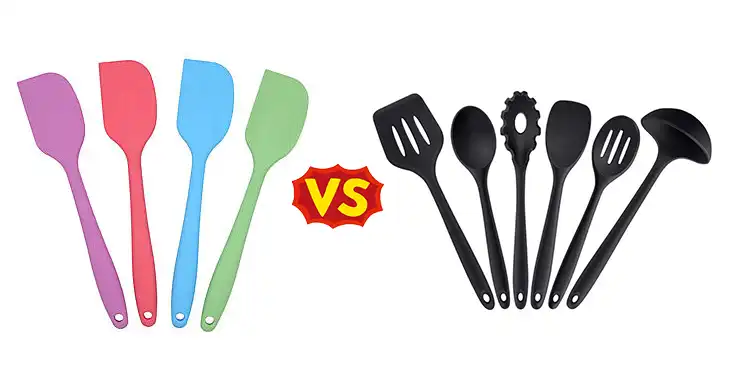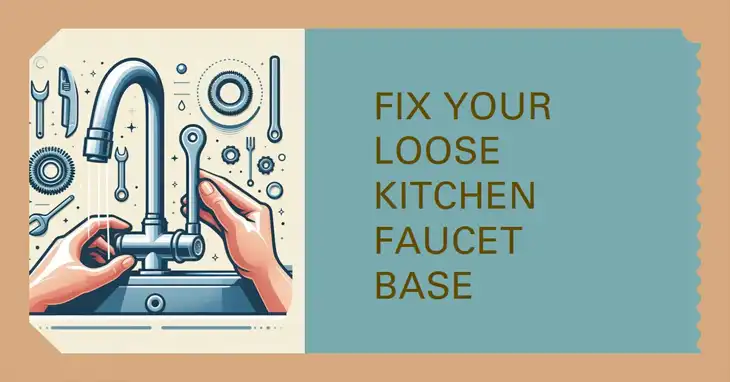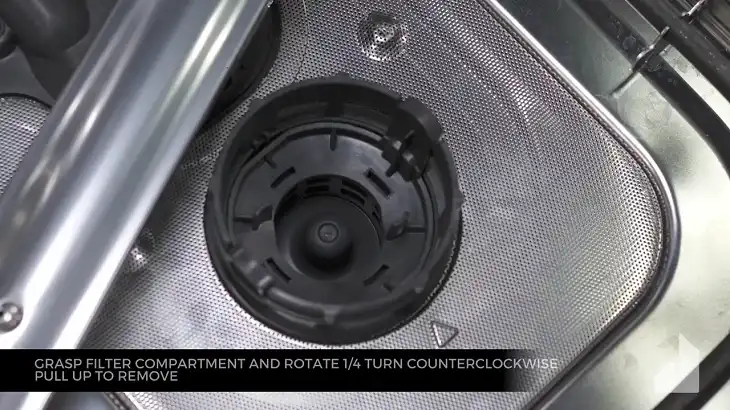Silicone vs Nylon Spatula | Explained
After entering the store, looking at silicone and nylon spatulas, wondering which to pick. Don’t worry, it’s a common head-scratcher! Both these kitchen tools are pretty great. They’re safe for your non-stick pots and pans, easy to clean in the dishwasher, and come in lots of fun colors and sizes. But wait, there’s more! They also have some big differences that can really matter when you’re cooking. In this article, I’ll talk about these differences. We’ll look at things like how much heat they can take, how bendy they are, and more. By the end, you’ll know just which spatula to grab for your next yummy meal. Let’s get started!

Side by Side Differences Between Silicone and Nylon Spatula
Before we get into the details, let’s take a quick peek at what we’re dealing with here. Silicone and nylon spatulas are like the Batman and Superman of the kitchen world – both superheroes in their own right, but with different superpowers. Let’s break down their key features and see how they stack up against each other.
| Feature | Silicone Spatula | Nylon Spatula |
| Heat Resistance | Up to 600°F (315°C) | Up to 400°F (204°C) |
| Flexibility | Highly flexible | More rigid |
| Durability | Resistant to cracking, chipping, melting | More prone to cracking and chipping |
| Odor/Stain Resistance | Less likely to absorb odors and stains | Can absorb odors and stains |
| Strength | Less rigid, may not handle heavy foods well | More rigid, good for heavy-duty tasks |
| Cost | Generally more expensive | More affordable |
Now that we’ve got a bird’s eye view, let’s swoop in and explore each of these features in detail. Buckle up, because we’re about to embark on a spatula-tastic journey!
Heat Resistance
When it comes to heat resistance, silicone spatulas are like those firefighters who run into burning buildings without breaking a sweat. These bad boys can withstand temperatures up to a scorching 600°F (315°C)! That’s hotter than most home ovens can even reach. So, whether you’re stirring a bubbling pot of marinara sauce or scraping the sides of a hot skillet, your silicone spatula won’t melt, warp, or leave any weird chemicals in your food.
On the flip side, nylon spatulas are no slouches either. They can handle heat up to 400°F (204°C), which is still pretty darn hot. To put that into perspective, it’s hotter than the recommended temperature for baking most cookies. But here’s the catch: if you accidentally leave your nylon spatula resting on the edge of a hot pan, you might come back to find it with a little mohawk-style melt. Yikes!
Real-life scenario: Picture this: You’re making caramel, and things get a bit too hot. With a silicone spatula, you’re golden. But with nylon? You might end up with a spatula that looks like it got too close to a lightsaber duel.
Flexibility
Next up, we’ve got flexibility. This is where silicone spatulas really shine. They’re like the gymnasts of the kitchen, able to bend and flex into all those nooks and crannies. Ever tried scraping the last bit of peanut butter from the jar with a rigid spatula? It’s like trying to get toothpaste back in the tube – frustrating and messy.
Enter the silicone spatula. Its flexibility allows it to conform to the shape of your bowls, jars, and pans. It’s like having a rubber-y tongue that licks every surface clean. No more wasted chocolate batter or salad dressing stuck to the sides!
Nylon spatulas, on the other hand, are more like the linebackers of the utensil world. They’re sturdy and less bendy. This can be a blessing when you’re dealing with heavier tasks, like folding in chunks of fruit into a dense muffin batter. But when it comes to getting into those tight corners or scraping down curved bowls, they might leave a bit behind.
Real-life scenario: You’re making a smoothie bowl, and you want every last drop of that expensive acai puree. A silicone spatula will be your best friend here, bending and scraping to get it all out. A nylon one? You might have to make peace with a little waste.
Durability
In the durability department, both spatulas have their own claim to fame. Silicone spatulas are like those indestructible toys you had as a kid. They resist cracking, chipping, and melting. You can drop them, bang them against the pot, or even let your toddler use them as a drumstick (not recommended, but we’ve all been there), and they’ll likely come out unscathed.
Nylon spatulas are tough too, but they have a bit of an Achilles’ heel. Over time, especially with frequent use and exposure to heat, they can become brittle. This can lead to chipping or cracking, especially if you’re using them to, say, break up ground meat in a hot skillet. And let’s be real, no one wants bits of nylon in their taco Tuesday feast.
Real-life scenario: You’re whipping up a batch of royal icing for holiday cookies. Your hand mixer slips, and the beater catches the edge of your spatula. With silicone, it’s likely just a scare. With nylon, you might be picking out tiny plastic shards. Icing on the cake? More like plastic in the icing.
Odour and Stain Resistance
Here’s a fun fact: your kitchen tools can have memories too, in the form of odors and stains. Silicone spatulas are like those friends who can keep a secret. They’re less likely to absorb odors and stains. So, even if you used it to stir a pungent curry last night, your morning pancake batter won’t taste like a trip to New Delhi.
Nylon spatulas, however, can be a bit more gossipy. They tend to hold onto odors and stains, especially if you’re working with turmeric, tomato sauce, or other colorful and aromatic ingredients. Have you ever made a white cake batter with a nylon spatula that still smells faintly of last week’s garlic bread? It’s not ideal.
Real-life scenario: You’re meal prepping for the week. Sunday is tomato sauce day, and Monday is vanilla pudding day. With a silicone spatula, no problem. With nylon, your pudding might have a hint of “eau de marinara.”
Strength
When it comes to sheer strength, nylon spatulas flex their muscles. They’re more rigid, which makes them excellent for heavy-duty tasks. Imagine you’re making a giant batch of mashed potatoes for Thanksgiving. A nylon spatula will plow through those spuds like a champ, mashing and mixing without bending out of shape.
Silicone spatulas, being more flexible, might struggle a bit with these Herculean tasks. They’re more likely to bend under pressure when you’re dealing with stiffer doughs or chunky mixtures. It’s like trying to dig a hole with a pool noodle – doable, but not ideal.
Real-life scenario: You’re making pizza dough from scratch. A nylon spatula will help you mix and knead that dough like a pro. A silicone one? It’ll do the job, but you might feel like you’re wrestling with a rubber band.
Cost: The Price of Kitchen Glory
Last but not least, let’s talk coins. Generally speaking, silicone spatulas are the bougie cousins of nylon ones. They often come with a higher price tag, thanks to their heat resistance, flexibility, and durability. It’s like choosing between a designer handbag and one from the mall – both carry your stuff, but one has a bit more prestige.
Nylon spatulas are more like the trusty, affordable backpack you’ve had since college. They get the job done without breaking the bank. This makes them a great choice for beginners, students, or anyone setting up their first kitchen on a budget.
Real-life scenario: You’re outfitting a kitchen for your kid heading off to college. A set of nylon spatulas will serve them well without cutting into their ramen noodle fund. But for your own kitchen where you’re whipping up gourmet meals? A silicone splurge might be worth it.
Our Verdict: And the Kitchen Champion Is
So, which spatula reigns supreme? The truth is, there’s no single winner. It all boils down to your individual cooking style and needs. Here’s a quick cheat sheet to help you decide:
- For high-heat cooking and maximum flexibility: Silicone Spatula
- For heavy-duty tasks and affordability: Nylon Spatula
The best approach? Why not have both in your arsenal? A silicone spatula for high-heat searing and scraping, and a nylon one for those heavy-lifting spatula moments. Remember, your kitchen utensil drawer should be your culinary companion, not a battlefield.





